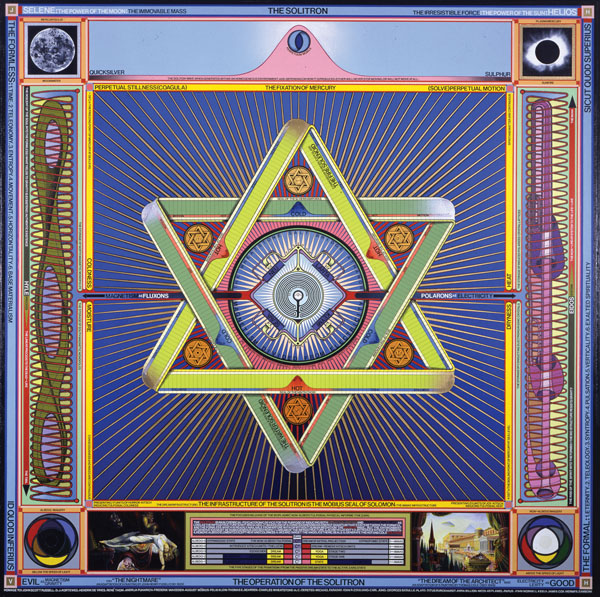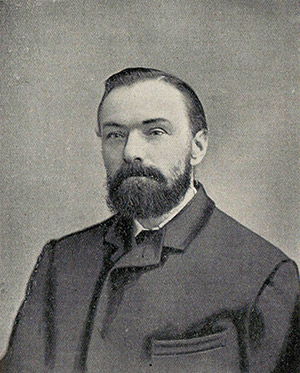Thursday, January 24, 2013
Blavatsky News
* In Spring 2013 Moderna Museet in Stockholm will be dedicating a major exhibition to Hilma af Klint (1862-1944), featuring many works that have never before been shown in public. “This retrospective exhibition of a Swedish pioneer of abstract art is Moderna Museet’s tribute to Hilma af Klint as one of the greatest Swedish artists. A woman artist whose work is still far too unknown to a wider public, Hilma af Klint eschewed representational painting as early as 1906. Between 1906 and 1915, she produced nearly 200 abstract paintings, some of which are in monumental formats.”
Like Vassily Kandinsky, Piet Mondrian and Kazimir Malevich, who have previously been regarded as the main protagonists of abstract art, Hilma af Klint was influenced by contemporary spiritual movements, such as spiritism, theosophy and, later, anthroposophy. Hilma af Klint’s oeuvre builds on the awareness of a spiritual dimension of consciousness, an aspect that was being marginalised in an increasingly materialistic world. When she painted, she believed that a higher consciousness was speaking through her. In her astonishing works she combines geometric shapes and symbols with ornamentation. Her multifaceted imagery strives to give insights into the different dimensions of existence, where microcosm and macrocosm reflect one another.
The exhibition will tour to Hamburger Bahnhof - Museum für Gegenwart, Berlin, 15 June-6 October 2013, and Museo Picasso Málaga, Málaga, 21 October 2013-9 February 2014. An exhibition catalogue, Hilma af Klint - A Pioneer of Abstraction, is published in collaboration with Hatje Cantz Verlag. A good tutorial on the significance of Hilma af Klint is provided by Gertrud Sandqvist in her lecture “When Spirits are guiding Your Hand” presented August 23, 2010 at the Salzburg International Summer Academy of Fine Arts.
* History Today (UK) for February 2013 has a reappraisal of William Stewart Ross (1844–1906) by Alastair Bonnett titled “The Agnostic Saladin.” "Ross was a maverick. He was also a man of public hatreds who preferred the company of the mystic Madame Blavatsky to that of atheists. For Ross the end of faith was a precondition of authentic spirituality. He declared that both religious dogma and atheism stood in the way of spiritual exploration."
Ross, who wrote under the name of ‘Saladin’, attended Mme. Blavatsky’s funeral cremation and published an account of that day and his reflections on her in the May 16, 1891 issue his Agnostic Journal. “Theosophy or no Theosophy, the most extraordinary woman of our century, or any century has passed away. Yesterday the world had one Madame Blavatsky—to-day it has none.”
Sunday, January 20, 2013
Theosophy and the Arts in the Modern World
A Call for Papers has been sent out for the Enchanted Modernities: Theosophy and the Arts in the Modern World Conference to be held at the University of Amsterdam, 25-27 September 2013.
Building on a very successful exploratory colloquium at Liverpool Hope University in December 2010, this conference will explore what the arts can tell us about the complex relationships between Theosophy, modernity and artistic culture c. 1875-1960. The purpose of this conference is to bring together an international group of scholars working on Theosophy and the arts across the globe in this period, and as a result, map the rich variety of artistic responses to the influence of Theosophy and the Theosophical movements in the modern world. The connections between Theosophy and modernist aesthetics have been well documented in relation to certain artists such as Kandinsky and Mondrian, as well as composers like Scriabin and Rudhyar. However, the purpose of this conference is to develop a more nuanced and complex picture of the multiple layering of art, modernity and mysticism in a range of artistic practices in the nineteenth and twentieth centuries. The wider critical significance of the relationships between painting, sculpture, applied and decorative arts, music, architecture on the one hand and Theosophy on the other, with the exception of a few well known case-studies, is still largely to be explored, possibly because, as the historian Alex Owen has suggested, ‘the very notion of mysticism and the occult seem to run counter to our conception of modern culture and the modern mind set’.
Individual papers might explore how artists, musicians and performers came into contact with Theosophy and other mystical doctrines or practices, and how Theosophical ideas, especially those of key figures in the Society in this period, such as Helena P. Blavatsky and Annie Besant, were given material, visual and audible form and shape.
Other topics of interest for the conference will include: the international artistic networks of the Theosophical movements (including R. Steiner’s Anthroposophy and post-Theosophical developments, such as G.I. Gurdjieff’s Work), the interrelations of mysticism, music and the visual arts; women artists/musicians and Theosophy; the artistic significance of A. Besant’s and C.W. Leadbeater’s book Thought Forms (1901).
The Enchanted Modernities project will sponsor the Conference in Amsterdam in 2013 and one at Columbia University in New York in 2015 as well as exhibitions and performances of Theosophically inspired music. A site for it has been set up at the University of York in the UK with more about its events and resources, which can be seen here. A bibliography of recent research on Theosophy and the Arts has already been made available as part of the site’s resources.
 |
| A patinated copper dish by Dutch Theosophist Frans Zwollo sr., 1914 |
The Mother of Modern Spirituality
The publicity campaign for Garry Lachman’s Madame Blavatsky: The Mother of Modern Spirituality continues. ReadTheSpirit, an online magazine “for readers who believe that spiritual diversity builds stronger communities,” has a January 14 post with an interview titled “Madame H.P. Blavatsky: Dawn of interfaith exploration.” Editor David Crumm, who says he has “often described her [Blavatsky] as a kind of P.T. Barnum of world religions,” and Lachman dialogue back and forth on the subject of the mysterious Madame but there appears to be some errors in the transcription, for it has Lachman saying things that go against what is known about her life:
“She stayed in New York for a while. Then, she had to leave for India by the mid 1880s because of scandal surrounding claims that she was a fraud.”
“Blavatsky herself says that Buddhism was the kind of teaching that she found on tablets in a monastery.”
And of course, the off-repeated old chestnut, “Yates [sic: W.B. Yeats] was asked to leave” her Society, which has already been put to rest here.
Even Lachman’s claim that “She’s the person who kick started modern spirituality” might be considered an overstatement.
Blavatsky is a catalyst who comes into people’s lives and stirs up things. Olcott probably wouldn’t have gone to India on his own, for example, but Blavatsky gets him to go to India and the Theosophist movement goes to India with them. Blavatsky’s message is this very positive forward-looking view of the progression of humanity out of slavery in the past into freedom. Even people like Thomas Edison took some ideas from Theosophy. People like Edison weren’t signed up to the full Theosophist creed, but they were attracted to some of the new ideas.
Thursday, January 17, 2013
Blavatsky News
* Garry Lachman’s Madame Blavatsky: The Mother of Modern Spirituality is reviewed in the February issue of Harper’s Magazine. The writer, John Crowley, presents not so much a review of the book as an outline of Mme. Blavatsky’s life with some misstatements. “HPB ignored Christianity when she didn’t despise it.” Yet over half her first book, Isis Unveiled, looked at the origins of Christianity, and she revisited the subject with a section intended for The Secret Doctrine dealing with Christianity and the mysteries, an area she examined extensively in her 1887 series “The Esoteric Character of the Gospels.” Perhaps the writer mistakes her dislike of the falsity of organized religion of her time (an opinion she shared with a number of Nineteenth Century writers) with Christianity.
“They [the Masters] were all living beings, said HPB, though they lived impossibly long lives,” the reviewer tells us. But in a letter to the Boston Daily Globe printed on March 8, 1889, she says: “They [the Masters] cannot live long centuries in one body. Though, since there are cases in the medical records of longevity reaching 175 years, there is nothing impossible in a man, knowing the occult sciences of certain plants and alchemy, making his body last even far beyond that period. But this, however, very few of them do.” “The French Count St.-Germain,” is listed in the review as being among those Masters who aided her over time, and Koot Hoomi is made an “assistant or secretary” of Morya. But these stumbles are minor in a “review” that runs seven pages. Unfortunately little space is given to what the writer thought of Lachman’s book.
* The New York Times, on the other hand, summarily dismisses her as a charlatan in a January 17 review of a recently opened New York show of artist Paul Laffoley: “Judging by his mandala-type compositions rendered in high-contrast colors and black and white, usually on square canvases, Mr. Laffoley has yet to encounter a system of mystical thought he could not absorb into his own project. Profusely annotated with press-on vinyl letters, his works refer to a dizzying array of mental adventurers, from Socrates to the Theosophist charlatan Madame Blavatsky.” In spite of this, the reviewer feels that the show still serves as “an excellent introduction to one of the most unusual creative minds of our time.”
 |
| The Solitron, 1997 Paul Laffoley |
Thursday, January 10, 2013
Blavatsky News
If a picture is worth a thousand words, then
* The house where Blavatsky was born, now a museum, as it looks in winter. Photo taken in Kirovs’kyi district, Dnipropetrovs’k, Dnipropetrovs’ka oblast, Ukraine. Before 1926 the town, still part of Russia, was called in Yekaterinoslav. The image comes from the photographer shotov; other examples of his work can be seen here.
* Blavatsky’s cremation urn as it looks today. The photograph was taken during the recent December 2012 Convention at the International Headquarters of the Theosophical Society at Adyar, India. The brass exterior has changed colour with age. The dome lifts up and would have contained her ashes. Thanks to the theosophical discussion site, Theos-talk, which brought it to our attention. Previous information about the ashes and the urn is given by us here.
* Mystery School, the site of Queensland, Australia, artist and musician Jhonny Russell, announces the release of a new silk-screen shirt: the 3-Eyed Mystic Shirt. Colours include black, light blue, blue, navy blue, green, and red, and sells for $60. Australian.
* The house where Blavatsky was born, now a museum, as it looks in winter. Photo taken in Kirovs’kyi district, Dnipropetrovs’k, Dnipropetrovs’ka oblast, Ukraine. Before 1926 the town, still part of Russia, was called in Yekaterinoslav. The image comes from the photographer shotov; other examples of his work can be seen here.
* Blavatsky’s cremation urn as it looks today. The photograph was taken during the recent December 2012 Convention at the International Headquarters of the Theosophical Society at Adyar, India. The brass exterior has changed colour with age. The dome lifts up and would have contained her ashes. Thanks to the theosophical discussion site, Theos-talk, which brought it to our attention. Previous information about the ashes and the urn is given by us here.
* Mystery School, the site of Queensland, Australia, artist and musician Jhonny Russell, announces the release of a new silk-screen shirt: the 3-Eyed Mystic Shirt. Colours include black, light blue, blue, navy blue, green, and red, and sells for $60. Australian.
Subscribe to:
Posts (Atom)



